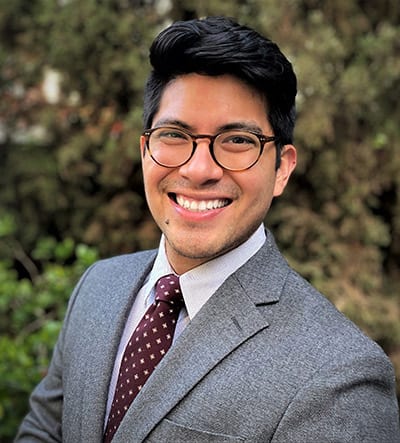Even as COVID-19 altered the legal landscape, Berkeley Law students engaged in compelling summer work encompassing a huge range of practice areas. Throughout the summer, we periodically presented first-person accounts from students doing intriguing work. This is the last entry in that series.
Rodolfo Rivera Aquino ’22 was born in San Salvador, El Salvador, and immigrated to the U.S. with his family when he was 10. He lived in Los Angeles and attended various community colleges before transferring to UC Berkeley, where he graduated with a B.A. in Political Science in 2015. Before law school, he worked as a legislative aide at the California State Assembly, where he staffed health and labor issues. Later, he was an analyst at the California Department of Finance in its Environment and Natural Resources section.
Below, Rivera Aquino describes his summer work experience as a judicial extern with the California Supreme Court:

I had my summer planned out. I’d continue my morning swim routine, then take BART into San Francisco to my externship at the chambers of California Supreme Court Associate Justice Leondra Kruger. I was so excited, in fact, that I did a dry run. But, like everyone else, the pandemic had other plans.
While my judicial externship was virtual (and my morning routine now includes HIIT workouts on YouTube), it was spent with an incredible institution of incredible people. While I did not set foot in the chambers during my externship, by the end of my 12 weeks I’d received the opportunity to delve deeply into issues in the law, improve my writing, and gain insight into judicial analysis that is seldom available to a rising 2L.
As the state’s highest state court, the California Supreme Court annually considers thousands of petitions and issues around 85 to 115 opinions that have statewide legal significance and national influence. Because of my previous professional experiences in the legislative and executive branches of California government, I understood the significance of the court.
Further, in law school, I learned how California jurisprudence remains influential and has paved the way in areas such as tort and privacy. Aside from my personal interest, I wanted to translate my legal education into the practical application of the law. An application at such a high-stakes setting dealing with highly important issues, I reasoned, would provide the best opportunity to improve my legal writing and research skills. When I was offered the opportunity to extern at the California State Supreme Court, I did not think twice.
Despite the ongoing pandemic, the work of the court continued — albeit virtually. Instead of the buzzing hallways, the chat function on Windows Teams provided a substitute. The meetings were now virtual, and my apartment was my office.
Even with the slow connections and inevitable speaking-while-the-microphone-is-muted phenomenon, the experience of being an extern was the same. I had the opportunity to work primarily on petitions for review, calendar memoranda (draft opinions), and preliminary responses (response by a justice to a circulating opinion). Each day, I worked on a novel issue of law that tested what I learned in law school.
My most treasured experience was the opportunity to provide recommendations on petitions for review. Each week, externs were assigned a petition that revolved around a legal issue that could go either way. We had a week to analyze the petition and provide a recommendation to the justice, in a virtual meeting, about how she should vote in the coming conference meeting (where justices decide whether to grant review). The issues varied from criminal law to state constitutional issues in response to the pandemic itself.
The analysis each petition required was different than what I was exposed to in law school — in an exciting way. In law school, we often take the hat of advocates or scholars of the law as presented to us. In my externship, the role changed to that of an arbiter who helps shape the law itself.
Necessarily, the analysis of the law changed as well. It included whether the issue presented by the petition was clear enough for the court to decide without complicating other areas of the law. It also included how the procedural stance changed the standard of review, and so, whether relief could even be granted.
Sometimes, there was a split in the law between courts that required clarity. Often, the law stood on one end and an equitable resolution stood on another. I enjoyed how the analytical process drew from both my legal mind and intuitions that arise from my professional and personal experiences. Instead of learning about the law, I had the opportunity to help shape the law through recommendations.
Despite the important work, a workplace is ultimately defined by the people. For me, it was defined as an incredibly friendly place where people join forces to carry on the institution’s critical functions. Because the court is composed of seven justices, collaboration is required.
Sometimes, the work required understanding how other chambers might weigh in on an issue. And because our efforts required an exacting due diligence, the friendly disposition of everyone was contagious. Working closely with clerks, who presented a variety of professional and personal backgrounds, created a diversity in perspectives that stimulated every project.
At the end of the externship, I reflected on the growth that can happen in 12 weeks. The pandemic has affected many areas of life and will likely continue to do so. However, the important work of the California Supreme Court marches on. I am happy and honored to have been part of it and now carry from it ongoing friendships and a deeper understanding of the formal and informal processes that come to shape the law.